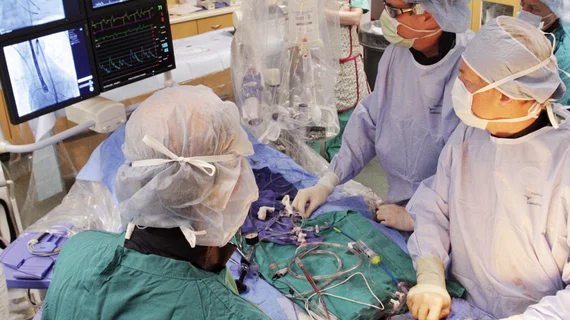TAVR survival is down in recent years, leaving cardiologists stumped
Patients may be less likely to survive after transcatheter aortic valve replacement (TAVR) now than they were just a few years ago, according to a new analysis published in JAMA Cardiology.[1] The study’s authors emphasized that the shift in mortality risk is relatively minor, but it does represent something to keep an eye on going forward.
“TAVR outcomes appear to have plateaued since 2018, despite the fact that the average patient treated with TAVR has become progressively younger, while the burden of both cardiac and noncardiac comorbidities has decreased,” wrote first author Suzanne V. Arnold, MD, MHA, a cardiologist with Saint Luke’s Mid America Heart Institute in Kansas City, Missouri, and colleagues. “During this time period, incremental improvements in both device technology and procedural techniques have continued as well—all factors that would be expected to lead to further improvement in outcomes.”
To take a closer look at this trend, Arnold et al. explored data from the Society of Thoracic Surgeons (STS)/American College of Cardiology (ACC) Transcatheter Valve Therapies (TVT) Registry. The group tracked more than 210,000 TAVR patients who underwent treatment from January 2019 to March 2022. Patients were excluded if undergoing transseptal TAVR or valve-in-valve TAVR. The median age was 79 years old, 43.4% were women and the median STS predicted risk of mortality score was 3.3%. As one may expect, patients selected to undergo TAVR became “progressively younger and less complex” as time went on.
Tracking recent TAVR outcomes
From 2019 to 2022, unadjusted 30-day mortality and in-hospital mortality decreased slightly, but the changes were not statistically significant. The 30-day adverse event rate dropped from 11.9% in 2019 to 9.2% in 2022, driven by a considerable reduction in major bleeding events. The rates of stroke and major vascular complications, however, did not change from 2019 to 2022.
The team’s biggest finding was that the adjusted odds ratio (OR) for 30-day mortality after TAVR actually increased over the course of the study. After adjusting for patient characteristics, the OR for 30-day mortality increased from 0.98 to 1.05 per year. It increased further to 1.09 per year when adjusting for procedural factors.
“Interestingly, short-term complications have continued to decrease modestly over this time period, but these trends have not translated into improvement in mortality,” the authors wrote. “In fact, when adjusted for patient-related and procedure-related factors, rates of 30-day mortality have increased over time, with relative increases of approximately 10% per year.”
The team did emphasize that these increases in risk-adjusted OR have remained “relatively modest.” However, even small differences in mortality can represent hundreds of TAVR patients who did not survive for 30 days after treatment.
“These findings highlight the importance of monitoring outcomes within the STS/ACC TVT Registry, which is uniquely positioned to both accurately capture these outcomes across U.S. hospitals and to appropriately adjust for patient and procedural risk,” the authors wrote.
Seeking answers, but coming up short on why TAVR mortality increased
Why, exactly, did risk-adjusted mortality risks increase over time? Arnold and colleagues performed a series of exploratory analyses to learn more, but they were unable to identify any site-level, patient-related or process-related factors that explained their findings.
The COVID-19 pandemic represents another possible explanation, but the group ruled that this was unlikely due to when the OR for 30-day mortality first started to rise.
“Moreover, risk-adjusted mortality continued to increase through 2021 and 2022, when case-fatality rates due to COVID-19 were decreasing,” they explained. “Certainly, if COVID-19 was a major contributing factor, this trend would be expected to quickly reverse on subsequent analyses.”
Arnold et al. concluded that their findings are worth tracking going forward, but not a significant reason to be alarmed.
“If these trends do not reverse (or at least stabilize), it would be reasonable to begin more in-depth research to identify the drivers of this concerning finding,” they concluded. “Similar efforts have been effective in reducing door-to-balloon times for patients with ST-elevation myocardial infarction and in standardizing care for acute myocardial infarction across U.S. hospitals.”
Click here for the full study.

